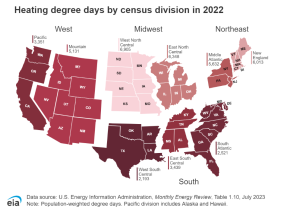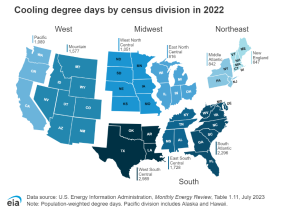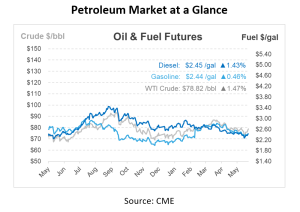
What’s That: Degree Days
When it comes to weathering the climate for comfort, not all days are created equal! Today’s What’s That Wednesday is covering degree days, a temperature tallying technique that helps keep our climate at optimal levels. So, before you turn down the heat this summer, let’s explore what degree days are and how you can use them to forecast your energy consumption.
What are degree days?
Degree days are a measure used in climate control to estimate the demand for energy needed to heat or cool a location. They are calculated from outdoor temperatures and are based on the assumption that when the outside temperature is 65°F (approximately 18.3°C), no heating or cooling is needed to maintain comfortable conditions. Here’s a breakdown of the different types of degree days:
Heating Degree Days (HDD): These are used to estimate the amount of heating required in a building. HDD is calculated for days when the average outdoor temperature is below 65°F. The HDD value is the difference between 65°F and the day’s average temperature. If the day’s average temperature is above 65°F, the HDD is zero.

Cooling Degree Days (CDD): These are used to estimate the amount of cooling required in a building. CDD is calculated for days when the average outdoor temperature is above 65°F. The CDD value is the difference between the day’s average temperature and 65°F. If the day’s average temperature is below 65°F, the CDD is zero.

For example, suppose the high temperature for today was 50 and the low was 30. If you divide 50 plus 30 by 2, it equals 40 degrees. To calculate the HDD, you would subtract 40 from the base of 65 to get 25 degrees.
Uses for Degree Days
This data serves several functions across various industries. Utilities and energy companies utilize this information to anticipate energy demands and effectively manage fuel supplies, especially during peak heating or cooling periods. In the realm of building design, engineers and architects rely on heating and cooling degree days to tailor the sizing and specifications of HVAC systems to ensure optimal performance. Similarly, the agricultural sector benefits from degree days data to forecast plant growth stages, manage pest control, and schedule crop planting and harvesting.
This data also aids economic analysts in assessing how weather variations influence economic activities, particularly within the energy and retail sectors. Climate researchers analyze long-term HDD and CDD trends to study climate change effects and predict future energy needs, contributing to more informed environmental policies and strategies.
How Degree Days Factor into Energy
Degree days are an important metric in the oil and gas industry, particularly for companies involved in distributing and selling heating oil, natural gas, and other fuels used for heating and cooling. The primary use of degree days in the oil and gas industry is for forecasting demand. Heating degree days and cooling degree days provide a quantitative measure of the need for heating or cooling over a period. A higher number of HDDs indicates a colder period, which suggests increased demand for heating fuels. Conversely, higher CDDs indicate warmer periods, potentially increasing demand for electricity for air conditioning, which can also affect natural gas consumption since it’s a primary source of power generation in many areas.
With accurate degree day data, companies can better manage their inventories. During periods predicted to have high HDD, companies might increase their fuel stocks to meet the anticipated higher demand. This helps avoid shortages and optimize supply chain costs.
Degree days can also influence pricing strategies in the energy market. During a period of high HDD, when demand for heating is high, prices might increase due to the higher demand. Companies use degree day forecasts to adjust prices dynamically, maximizing profitability while managing consumer expectations and competitive pressures.
Companies need to align their logistics and distribution plans with the expected demand for operational efficiency. Degree day data helps in planning the deployment of delivery trucks, scheduling maintenance of infrastructure, and managing staffing needs.
Traders in energy markets use HDD and CDD data to make informed decisions about buying and selling energy commodities and derivatives. These metrics help traders anticipate market movements based on weather patterns, potentially leading to profitable trading opportunities.
Degree days also play a role in risk management, helping companies prepare for fluctuations in demand that could affect financial performance. By understanding potential demand shifts through degree days, companies can hedge their fuel supplies, set appropriate financial reserves, and plan for alternative sourcing strategies during extreme weather conditions.

This article is part of Daily Market News & Insights
MARKET CONDITION REPORT - DISCLAIMER
The information contained herein is derived from sources believed to be reliable; however, this information is not guaranteed as to its accuracy or completeness. Furthermore, no responsibility is assumed for use of this material and no express or implied warranties or guarantees are made. This material and any view or comment expressed herein are provided for informational purposes only and should not be construed in any way as an inducement or recommendation to buy or sell products, commodity futures or options contracts.





